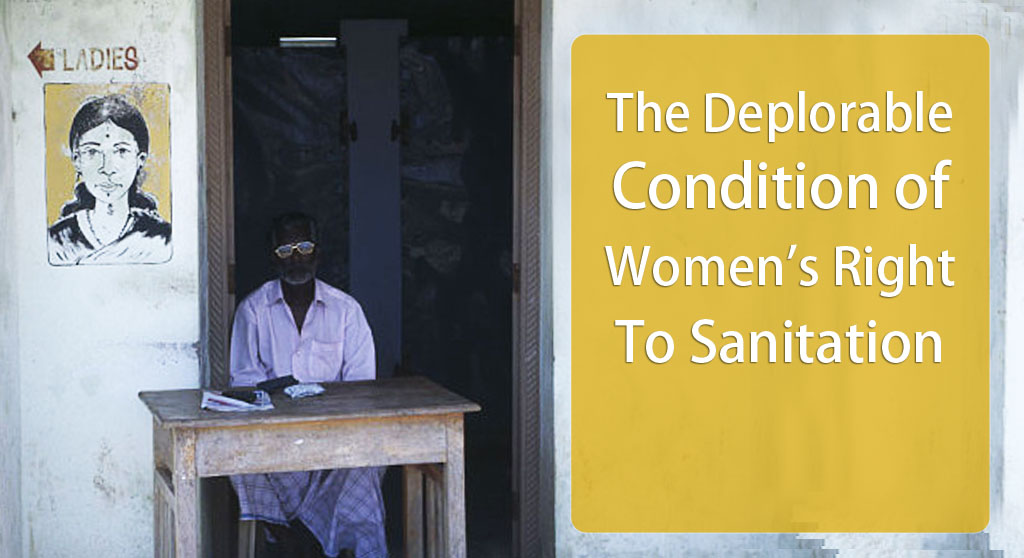The Deplorable Condition of Women’s Right To Sanitation
As a child, completely aware about the struggles of being born female, but completely unable to reason out the differences in treatment, I used to be astonished at the crude practice of females having to pay for using public toilets, when males had to pay nothing or less. As a just turned 21 year old I am still astonished at the same just that my reasoning skills have improved! At one point of time, I used to wonder maybe urine is actually sold, just like all the cut hair is sold by salons, and probably female urine sells for less, that’s why we need to pay for it! As ridiculous as my childhood logic is, the practice of women paying to pee whereas men don’t have to, is absurd!
[inlinetweet prefix=”” tweeter=”” suffix=””]As of 2013, more than half of 1.2 billion Indians did not have access to sanitation.[/inlinetweet] A 2009 study by The Centre for Civil Society states that Mumbai has 132 public restrooms(most of which are not functional) for women as compared to 1534 for men. In rural India, women can’t go to the fields during the day as men do, to urinate or defecate; at night it puts them at risk of contracting diseases, besides sexual predators looking out for them.
In 2012, a ‘right to pee’ movement was launched by 35 NGOs in Mumbai. They had three demands – [inlinetweet prefix=”” tweeter=”” suffix=””]women should be allowed to pee for free[/inlinetweet],[inlinetweet prefix=”” tweeter=”” suffix=””]public toilets should provide sanitary napkins to women like they provide condoms to men,[/inlinetweet] and that [inlinetweet prefix=”” tweeter=”” suffix=””]women’s toilets should have changing rooms.[/inlinetweet] This was the second consecutive attempt of these NGOs; the first attempt in 2011 didn’t get any reply from the civic body. So what’s the situation now in 2015? Well,[inlinetweet prefix=”” tweeter=”” suffix=””] I had to pay Rs.5 to empty my bowels at Churchgate station yesterday[/inlinetweet], while men tramped in and out of their restroom even with empty pockets!

But the ‘right to pee’ wasn’t the first-of-its-kind movement. 2007 had seen the Haryana government passing the ‘no toilet, no bride’ campaign, discouraging females to marry into families who don’t have a toilet in their house.
The recent “Jaha-soch-waha-shauchalay” campaign branded by Vidya Balan throws some light to the issue of female sanitation in rural areas.
If I go beyond the basic misogyny and pervertedness, and look at the economical aspect of it all, then ladies generate a kind of waste in the bathroom that men don’t- sanitary napkins or tampons. Indian public toilets for women rarely have separate dustbins to throw these. That, coupled with the hatred and fear of menstruation, cleaners demand more wage for cleaning women’s bathrooms.
But, even leaving behind the extra garbage that women produce in the bathroom, for all other gender-specific goods in the market,[inlinetweet prefix=”” tweeter=”” suffix=””] do men and women pay the same for the same item at the same place? [/inlinetweet] Well, a study at the University of Central Florida had found that on average, deodorants for women costed 30 cents per ounce more than that of males’, that too just for a different smell. If you look around you can see the difference in pricing of trivial things like haircuts and T-shirts; if you delve into it, the differences in the amount men and women pay for bigger investments will catch your eye! I would have loved to quote the results of a study done by some Indian university, but we are far from realizing these problems.
So when I’m paying much more for a simple haircut than my male counterpart, can I expect equal treatment for peeing and menstruating?
Image source: http://bit.ly/1ddzLk4
Shreya is an undergraduate Statistics student. Her loves include food, travel and writing. Smiling and being a loner comes naturally to her!
Editor: Divya Rosaline
1



